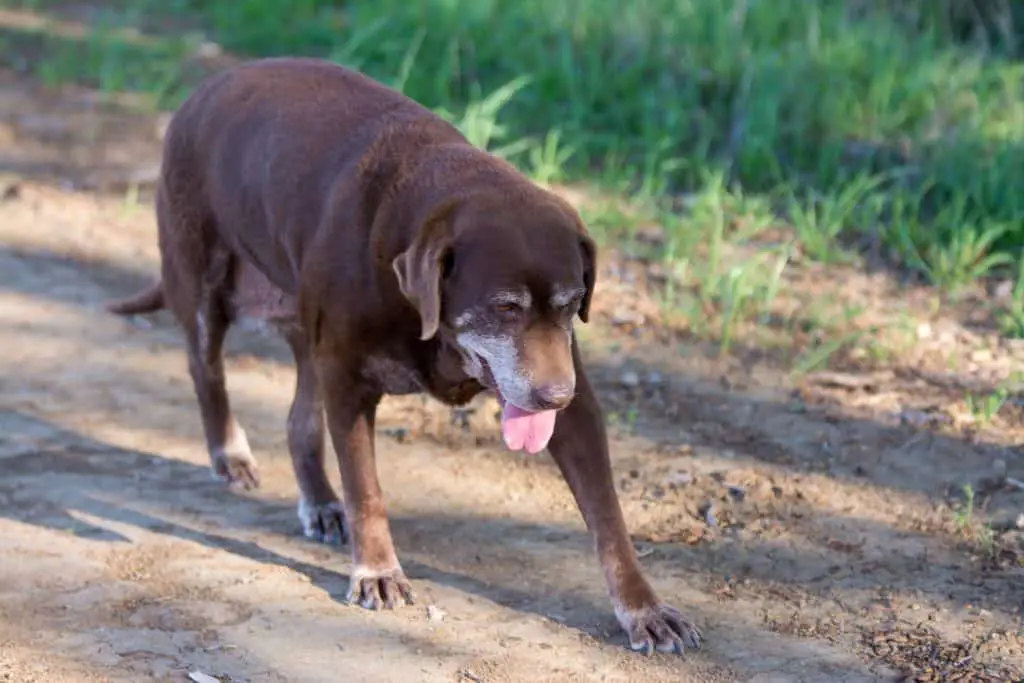
Labradors are generally known to be fun-loving, active dogs. They are ever ready to be your loyal companion whether you want to go for a jog in the park or play in the garden with kids. But what happens if one day you notice that your Lab is not even able to walk properly, let alone run with you?
It can be distressing to see your pet bogged down with a condition that hampers its ability to walk. If you find out the root cause early, you may be able to help your dog in the best possible way. Read on to know more about the possible reasons why your Labrador is having trouble walking and what you can do about it.

Possible Reasons Labradors Cannot Walk
Although your vet is the best judge when it comes to any condition your lab is suffering from, your dog is probably unable to walk because of one or more of the following conditions.
Hip Dysplasia
Hip Dysplasia is a condition in which your lab’s weight-bearing bone, the femur, does not fit well within its socket. Although this condition may be present in puppies, too, it usually does not cause a problem until your dog gets older. As the dog ages, this condition causes joint pain and hampers mobility. Genes and nutrition are both known to be responsible for hip dysplasia. It is one of the most common Labrador back leg problems that hinder its ability to walk.
Elbow Dysplasia
Another condition that may be either genetic or environmental, elbow dysplasia affects the flexibility of the forelimbs in a Labrador. It is usually caused by abnormal growth of bones or tissues around the elbows, which causes the joints to degenerate over time. It also causes flaking off of the bones and can result in fractures as well. This is another condition that can be diagnosed at an early age, but it causes most of the mobility issues as your lab gets older. Related post: Elbow & Hip Dysplasia in Labradors
Arthritis
The science behind arthritis in dogs is similar to that behind the condition in humans, that is, the cartilage begins to wear out, leaving the joints vulnerable and painful. When attacked by arthritis, your lab may be reluctant to move the particular limbs that have been affected and prefer to sit for longer hours than walk. Lack of movement further deteriorates the condition and causes more Labrador back leg problems. Arthritis is more common in the joints around the dog’s hips and knees. Related Post: Signs of Arthritis in a Dog

Spinal Trauma
If your dog ever had a car accident, a severe bite, or another form of direct injury to the spine, spinal trauma could rob it of its ability to walk properly. It can also be caused due to certain medical conditions in which blood supply fails to reach the spine adequately. Depending on the severity of the trauma, your dog could lose its ability to walk temporarily or it could be long-term. Also, it becomes harder to recover from spinal trauma at an older age than if your dog is a young adult.
Intervertebral Disk Disease (IVDD)
IVDD is a painful condition caused by the hardening of the discs of the vertebral column. Over time, it continues to degenerate and causes the spine to be in bad shape. IVDD can also be made worse if your dog experiences a sudden fall that ruptures the already weakened vertebra. This condition makes it difficult for dogs to walk when severe. In extreme conditions, IVDD might also cause paralysis, meaning that your dog may not be able to walk at all, except with the aid of a wheelchair.
Degenerative Myelopathy
It is a genetic condition that is similar to Lou Gehrig’s disease in humans. A neurodegenerative disease, the progression of the condition affects your lab’s ability to walk. It cannot be cured, much like Lou Gehrig’s disease, so support for your dog’s hind legs is the only option. It usually affects older dogs and begins with weakness in the back legs. This disease typically does not cause pain, but as it gets worse, mobility begins to get hindered in other parts of the dog’s body and is not limited to the legs.
Tumors
Tumor of the bone, scientifically known as Osteosarcoma, is another extremely painful condition that may cause your lovable Labrador to stop walking. The exact cause of this disease is not known, but it has been seen to be caused by both genetic as well as environmental issues. In this condition, abnormal growth of cells breaks down bones easily, causing inflammation and pain in the limbs. It can occur in both the back legs as well as the forelimbs and occasionally spread to other regions such as the hips and pelvis. There is no cure as this disease is a malignant form of a tumor.

What Should You Do if Your Labrador Has Trouble Walking?
As soon as you notice your Labrador having trouble walking, do not delay in finding out the root cause. As you try to diagnose, take the following steps.
Visit Your Vet Immediately
Not all root causes are easy to identify at home as similar symptoms can arise from many different underlying conditions. If your dog refuses to walk or is struggling to keep up, it is best to seek professional help at the first chance. A veterinarian can review the dog’s medical history, understand its genetic disposition, consider environmental changes (if any), and then finally diagnose the condition. It could be a simple condition that causes an acute inability to walk and is treatable or it can be life-threatening. Either way, let the professionals provide recommendations.
Consider a Dog Wheelchair if Treatment is Unavailable
Depending on the diagnosis, your vet will tell you whether your dog’s condition is treatable. If it is, well and good. But if not, you may want to invest in some kind of walking support for your dog. A rear support wheelchair is a good option if your dog has a condition that affects the mobility of its back legs only. Full-support wheelchairs, on the other hand, are ideal for dogs that have lost control over all four limbs, such as in advanced cases of degenerative myelopathy.
Consider CBD Oil for Pain Relief
Conditions such as arthritis and hip dysplasia tend to cause chronic pain and inflammation. One of the well-researched remedies for pain relief is CBD oil or Cannabidiol. Extracted from the hemp plant, CBD oil has several benefits without the intoxicating properties of marijuana. With the right dosage of CBD oil, you can also reduce pain medications that you have been giving your dog for arthritis and other kinds of joint pain. Always buy good quality, vet-approved CBD oil for your loving pet. Related Post: Benefits Of CBD Oil For Labrador Retrievers

How to Prevent Joint Issues in Dogs?
Even though some health conditions that cause joint pain and obstruct mobility in your lab are genetic, there is always a certain degree of environmental influence involved. With proper care, it is often possible to prevent joint issues in dogs. Here are a few pointers.
Nutrition and Weight Management
With larger breeds such as a Labrador, puppies often tend to grow quickly into adults. This causes their bones to develop faster than their bodies, weighing heavily on them. A balanced diet is crucial to maintaining proper bone density and managing your dog’s overall weight. As puppies begin to grow into adults, weight management becomes all the more important. Adult dogs tend to overeat, which can consequently be detrimental to joint health. Overfeeding your dog must be avoided at all costs to maintain flexibility. Related Post: Can Labradors Eat A Raw Meat Diet?
Regular Exercise
If your beloved pet is reluctant to walk because of joint pain, do not push it into rigorous exercise. However, mild exercise is necessary to keep joints healthy. Exercising also provides lubrication to joints, preventing arthritic conditions or keeping them from getting worse. Go for gentle walks if your dog feels uneasy to run. Try relaxing your dog afterward by putting it into a warm bed or by giving it some massage therapy. Remember, not exercising your dog may lead to excessive weight gain, which can prove to be a bigger foe for its joints. Related Post: How Much Exercise Does A Dog Need?
Nutritional Supplements
Sometimes, a balanced diet is not enough in preventing your dog’s mobility from succumbing to joint issues. Adding good quality supplements to the diet can go a long way in keeping your pet healthy and agile for a long time.
Look for supplements that have ingredients that strengthen the bones and joints. Some of the active ingredients that provide great value are glucosamine, chondroitin, coenzyme Q10, hyaluronic acid, spirulina, and turmeric. As secondary ingredients, it is also a good idea to look out for vitamins and minerals that help retain bone density.
Regular Vet Check-Ups
Just as you go for regular health check-ups at your primary care physician, similarly, you should ensure regular appointments are made with the vet for your loving dog. Do not wait to take it to the vet until after it has developed a condition. Prevention is always better than medication. During regular check-ups, your vet can identify possible health triggers for your dog and recommend prevention measures accordingly. Also, degenerative diseases that impair mobility should be diagnosed sooner than later to improve your dog’s quality of life.

Related Post: Senior Dog Care Tips For Labrador Owners
DNA Testing to Determine Hereditary Conditions
It is always a good idea to perform DNA testing to determine genetic predispositions in your dog as early as you can, preferably at a puppy age. DNA tests are simple swab tests and are typically painless. DNA testing can tell you whether your dog is likely to develop a chronic condition that affects its mobility in the future. This way, you can be prepared for if and when your pet develops that particular condition and begin investing in the right resources at the earliest.
Quality of Life Matters
While it is heartbreaking to see your once active Labrador refusing to walk or play with you anymore, remember that your dog is still your best friend and is loyal to you, wanting nothing in return. Doing the best that you can in finding out the underlying issues when walking is a concern for your lab. Talk to the vet about providing the best possible support in terms of improving the quality of life for your lab. Ease its chronic pain through diet and supplements, and give it your precious company that it will always crave till the end.
If you want to find the best pet insurance for your labrador, click here
Primary Sources
- https://dogbreedslist.com/dog-breeds/labrador-back-legs-giving-out/
- https://www.labradortraininghq.com/labrador-health-and-care/hip-dysplasia-and-labradors/
- https://www.thelabradorretriever.com/elbow-dysplasia-in-labrador-retrievers/
- https://wagwalking.com/condition/spinal-trauma
- https://vcahospitals.com/know-your-pet/osteosarcoma-in-dogs
- https://www.handicappedpets.com/blog/ivdd-in-dogs/
- https://www.handicappedpets.com/blog/5-need-to-know-dog-wheelchair-tips/
- https://www.handicappedpets.com/blog/cbd-oil-for-improved-pet-mobility/
- https://www.thekennelclub.org.uk/health-and-dog-care/health/getting-started-with-health-testing-and-screening/dna-testing/
- https://www.petcarerx.com/article/5-ways-to-prevent-joint-problems-in-your-dog/103
- https://www.petlisted.com/best-joint-supplements-for-dogs/


